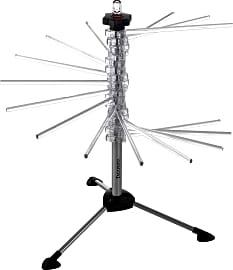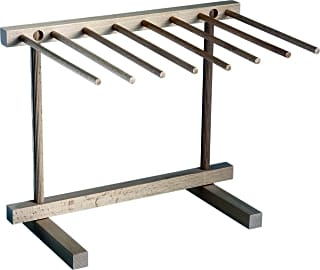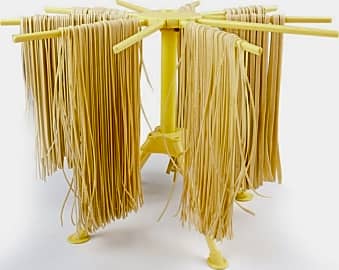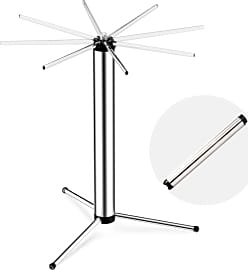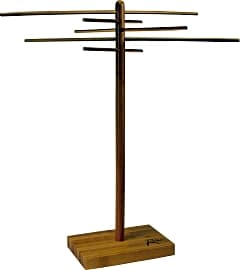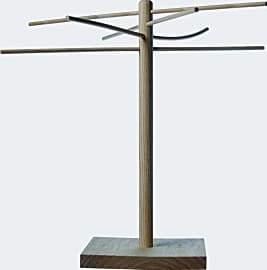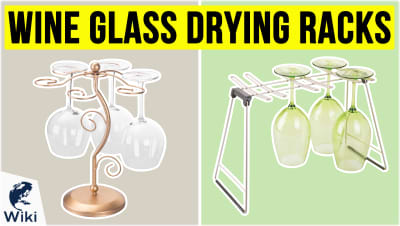The 8 Best Pasta Drying Racks

This wiki has been updated 42 times since it was first published in August of 2015. As with most foods, homemade pasta tastes much better than the dried, store-bought variety, but the process of making it can be tricky. If you fancy trying your hand at some authentic home-cooked Italian meals, yet dread the preparation, one of these drying racks will make it easier and may tempt you to give it a go. Most collapse for storage, so they're suitable for those with small kitchens. When users buy our independently chosen editorial recommendations, we may earn commissions to help fund the Wiki.
Editor's Notes
July 30, 2021:
We removed a bench-style rack that's tough to find now because its design made it hard to get the product in and out without wrinkling or cracking. The rest of the Wiki hasn't changed much, although we did elevate the Marcato Atlas to the number 2 slot due to its high capacity. Another interesting choice is the Hin Plus Scratch, which we like quite a bit because of its folding design that makes it easier to store than most. The Kitchendao Rotary is another that folds up for easy storage.
March 26, 2020:
When it comes to drying pasta, you want a rack that's sturdy, which is why we have kept both the KitchenAid Stainless Steel and the Bellemain Large as top choices. These stand securely during use, then fold down so they aren't in your way when they're not needed. For something a little different than the traditional tree-style racks, we've kept Fante's Natural, which looks something like a small folding stool or chair. Its 12 linear feet of space should give you room for even your bigger batches, and when you've finished, it folds neatly for storage.
If you'd like something even more simple than the aforementioned models, consider the Hin Plus Scratch or the Weston Bamboo. These affordable options should fit in anyone's budget, although they're on the smaller side, so you may need to stick to smaller batches. Finally, at the opposite end of the price spectrum, we've selected the Eppicotispai 9-Piece. It comes with a range of tools for making pasta at home, including a spaghetti rolling pin and curved pasta cutter, making it a great gift for that person in your life who loves kitchen gadgets. Those who are new to cooking might find it to be a bit much, though.
Special Honors
StazioneDiDondolegno Pasta Dryer The StazioneDiDondolegno Pasta Dryer looks like a rack for hanging clothing out to dry, which isn't necessarily a bad thing — this shape allows it to offer more space than most. Open, it stands about 16 inches tall and 24 inches long, but it folds up for storage, so you don't have to worry about it taking up too much room. etsy.com
Why Fresh, Homemade Pasta Is Better
Homemade pasta is significantly cheaper than store-bought pasta.
There are many reasons why homemade pasta is superior to its dried brethren found on store shelves. Let's start by looking at the ingredients in two of the most commonly found store-bought brands: Barilla and Ronzoni. Both are made with semolina, durum wheat flour, and water. Homemade pasta is made with semolina flour and eggs. Did you catch the major difference there? Fresh homemade pasta has eggs, but the majority of dried, store-bought pastas contain water in lieu of eggs. This means that homemade varieties are actually healthier. Eggs are one of the healthiest foods on the planet. They are loaded with vitamins A, B12, B2, and B5, as well as the powerful anti-oxidant selenium, and, of course, protein. They also contain trace amounts of nearly every other vitamin the human body requires. In addition, they have a high bioavailability, meaning the body absorbs a large percentage of the vitamins and minerals contained within the egg.
Anybody who has ever tasted homemade pasta, whether in a home or restaurant, knows that it simply tastes better. It is hard to describe it to someone who has never eaten it, but the texture, consistency, and flavor of homemade pasta are all noticeably better than in store-bought pastas. Rather than just being a vessel for whatever sauce the chef puts on it, homemade pasta is actually the star of the dish. This means that fresh pasta is often best when you prepare it with a simple sauce that doesn't attempt to completely overpower its flavor. Since it absorbs sauce better than dried, store-bought varieties, you won't have to use as much sauce to create a memorable dish, either.
Making homemade pasta also allows you to experiment with the ingredients. You can try adding roasted red peppers, spinach, garlic, cracked black pepper, or any other ingredient you think will enhance the flavor of the completed dish. Sure, you can buy some pastas at the store with additional ingredients, but you'll be limited to just a few popular flavors.
One last benefit of making pasta at home is the price. Homemade pasta is significantly cheaper than store-bought pasta. Homemade pasta can cost as little as a penny per ounce, even if you make it with the best quality ingredients you can find.
Why You Need To Dry Homemade Pasta
Whether you plan on cooking your pasta right away or storing it for consumption at a later date, you should dry your homemade pasta. When you should dry your pasta and for how long depends on what type of pasta you make and what you will be doing with it. If you plan on cutting your pasta into noodles, like spaghetti or pappardelle, you should allow it to dry for roughly 15 minutes after you have rolled it out. This will make the dough less sticky and make the cutting process easier, whether you will be doing it by hand or with a machine. Don't let it dry too long, though, otherwise it may crack as you cut it.
If you don't completely dry it out, there is a chance it could spoil during storage.
If you are making stuffed pasta, such as ravioli or tortellini, you shouldn't dry it until after you have finished stuffing it. Drying it beforehand will make it harder to achieve a leak-proof seal.
You should dry both stuffed pasta and noodles for at least 15 minutes before cooking. A short drying period allows the pasta to firm up a little bit so that it will keep its shape better when dropped into the boiling water. It also makes it less sticky, so there is less chance of it clumping during cooking. Drying pasta is even more important if you plan on storing it at room temperature for later consumption. If you don't completely dry it out, there is a chance it could spoil during storage.
To dry your pasta, you have two options. You can simply lay it out on a floured surface. This requires you to flip it regularly to ensure it dries evenly. Or, you can use a drying rack. Drying racks only work with noodles, since it is nearly impossible to hang stuffed pasta, but it is the best and easiest method. Using a drying rack ensures that your pasta will dry evenly, and it frees up your counter space to work on other food prep, like making the perfect sauce to accompany your noodles.
What To Consider When Choosing A Pasta Drying Rack
Buying a pasta drying rack is a relatively simple endeavor when compared to buying a variety of other items, like trying to choose the best computer or DSLR camera, as there are only a few things to keep in mind.
First, consider how much pasta you plan on making. If you know that you are going to make your pasta in large batches, which we highly recommend, choose a drying rack that can accommodate your needs. Some models may offer as a little as five feet of total drying space, while others may offer 12 feet or more. Second, consider the type of pasta you want to make. If you like to make long lasagna or fettuccine noodles, choose a model that has enough height so that the ends of your pasta don't lie flat on the counter. Third, consider the material the drying rack is made from and how easy it is to clean. Plastic varieties are generally easier to clean, but aren't as aesthetically pleasing. There is also a higher chance of your noodles sticking to a plastic rack, so make sure to flour the pasta liberally if using a plastic model.
The final consideration should be ease of storage. If you have a large kitchen, this may not be an issue, but for most of us, a folding or collapsible model is the best choice. This way, you'll have plenty of drying space for your noodles when you need it, but when you are all done cooking, you can easily tuck the rack away into nearly any cabinet.


